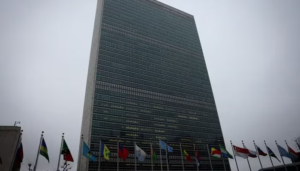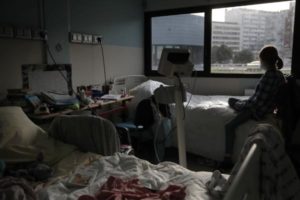The nineteenth-century French historian and orientalist Ernest Renan once observed that forgetfulness and historical error are crucial elements in the creation of a nation. To be sure, that observation has proven particularly relevant in the reborn nation states that emerged from the ruins of the Soviet empire.
This is especially so in the Baltics, which had enjoyed only a brief period of independence in the interwar years before their rapacious eastern neighbor gobbled them up whole. In June 1941, the equally rapacious Germans flushed the Red Army out, but by the summer of 1944, it was back.
Until the end of the 1980s when the first holes became visible in the Iron Curtain, there was little cause to believe that Moscow would ever loosen its vice-like grip on what were called in émigré circles “the captive nations.” Only a handful of octogenarian diplomats in exile continued to keep that flame of hope flickering, even as most of their compatriots at home had long since thrown in the towel and resigned themselves to life under Soviet suzerainty.
But then the unimaginable happened. The Soviet Union collapsed. Lithuania, Latvia, and Estonia could finally determine their own destiny and rejoin the family of nations. Within a short time, all three firmly embedded in NATO and the European Union. Had someone forecast such a turn of events in the 1980s, he or she would have been sent for a psychiatric examination.
However, the road to national rebirth, to say nothing of national renaissance, has been marred by an unremitting refusal on the part of these countries to confront the sinister chapters in their wartime history—and the ghosts that will never cease to haunt them until a final reckoning is achieved. Nowhere is this more evident than in Lithuania, once a mighty citadel of Jewish life and learning whose rabbis, scholars, and educational institutions were celebrated across the Jewish world
Tragically, that ago-old Jewish community was annihilated in a frenzy of unimaginable violence. The names of the killing fields across the length and breadth of the country, the names of which are little known except to Holocaust researchers and the progeny of those who perished there. The destruction of Lithuanian Jewry was carried out with chilling ferocity and bloodlust, and members of the local population set upon their Jewish neighbors with sadistic zeal even before the German invaders had reached the gates of several Lithuanian cities and towns, let alone established their administration there.
One of the most horrifying such massacres took place on June 27, 1941, at the Lietukis Garage on Vitautas Avenue in Kaunas (Kovno). On that occasion, dozens of Jews were tortured and murdered with shovels and iron rods in a manner that even shocked one of the German officers who witnessed the outrage.
Describing that fiendish scene, Lothar von Bischoffshausen called it a “display of brutality that was unparalleled by anything [he] had seen in combat during two world wars. Standing on the tarmac in the yard was a fair-haired young man of around 25. He leaned on a long iron bar as thick as a human arm and around his feet lay between 15 and 20 people who were either dying or already dead. A few feet away from him stood another group of individuals who were guarded by armed men. Every few minutes he signaled with his hand and another person quietly stepped forward and had his skull shattered with one blow from the huge iron bar the killer wielded. Each blow he struck drew another round of clapping and cheering from the enthralled crowd.”
That was the horrifying opening act to the Holocaust in Kaunus, Lithuania’s interwar capital, the population of which was more than 25 percent Jewish. By December 1941, the Germans and their local henchmen had already butchered more than half the Jews in the city. Only a few hundred lived to bear witness to the acts of barbarism they had endured.
Fast forward to the summer of 2020, when Lithuania’s parliament, the Seimas, decided that 2021 would be devoted to honoring the memory of Juozas Lukša. Under the pseudonym “Daumantas,” Lukša was a member of the Lithuanian Activist Front (LAF), which worked hand in glove with the Germans and also played an active role in the destruction of Lithuanian Jewry. Not mere bystanders or even facilitators, many of the LAF militia men, whose own manifesto called for Lithuania to be purged of Jews, were behind the trigger when their Jewish neighbors were mowed down. Others rounded up Jews, tortured them, and greedily plundered their last possessions. Eyewitnesses have placed Lukša at the scene of the garage massacre, and while there is no conclusive evidence that he wielded a pipe, he is implicated in other acts of murder.
Lukša went on to become one of Lithuania’s best-known partisans in the struggle against the returning Soviets. In 1946 he managed to leave his native land and wound up in Paris. There, he penned a book that became a kind of manifesto in anti-Soviet Lithuanian emigre circles. In 1950 he was parachuted back into Soviet Lithuania where he was eventually killed.
Instead of glorifying Lukša, one would hope that Lithuanians would pay tribute to the men and women who wrote, perhaps the most inspiring chapter in the wartime history of their nation — those who vigorously resisted the call to annihilate their neighbors and upheld the values of human decency and their own country’s good name. They should be hailed as heroes not because their behavior was representative of Lithuanian society’s behavior during the Holocaust, but because it was not. Exceptional behavior is what heroism is all about.
A more suitable object of admiration would be someone like Antanas Paškevicius. A colorful and prolific anthropologist, Esperantist, journalist, and traveler, Paškevicius, spent many years in India and other eastern lands, which he toured by motor bike. Upon his return to Lithuania, he found work as director of a library in Vilnius.
Risking his life, Paškevicius hid several Jews in the library and another, fellow Esperantist Akiva Gerszater, in his own home. He also worked to conceal Jewish materials that had been designated for destruction. When the Soviets reoccupied the country, he was arrested for attempting to preserve library materials he had been ordered to pulp. Paškevicius was then sent to the Gulag and later to internal exile. He was only allowed back to Lithuania in 1959. His eight-volume From the Baltic Sea to the Bay of Bengal was published posthumously in 1992. Sadly, most of his other work never appeared in print.
Of course, no outside iconoclast, however well meaning, should determine just who Lithuanians (or anyone else for that matter) install in their own pantheon — and who they remove. Other societies (in the same neighborhood with their own tortured histories are facing a similar challenge; history in this part of the world can only be written (and transmitted) with meticulous attention to documentation, with equanimity and nuance. Above all, this process must be undertaken from within, and patriotic writers such as Ruta Vanagaité have begun to do so. Only then will they have transcended the state of nation building to which Renan referred. As Ernest Hemingway once observed, “As you get older it is harder to have heroes, but it is sort of necessary.”




